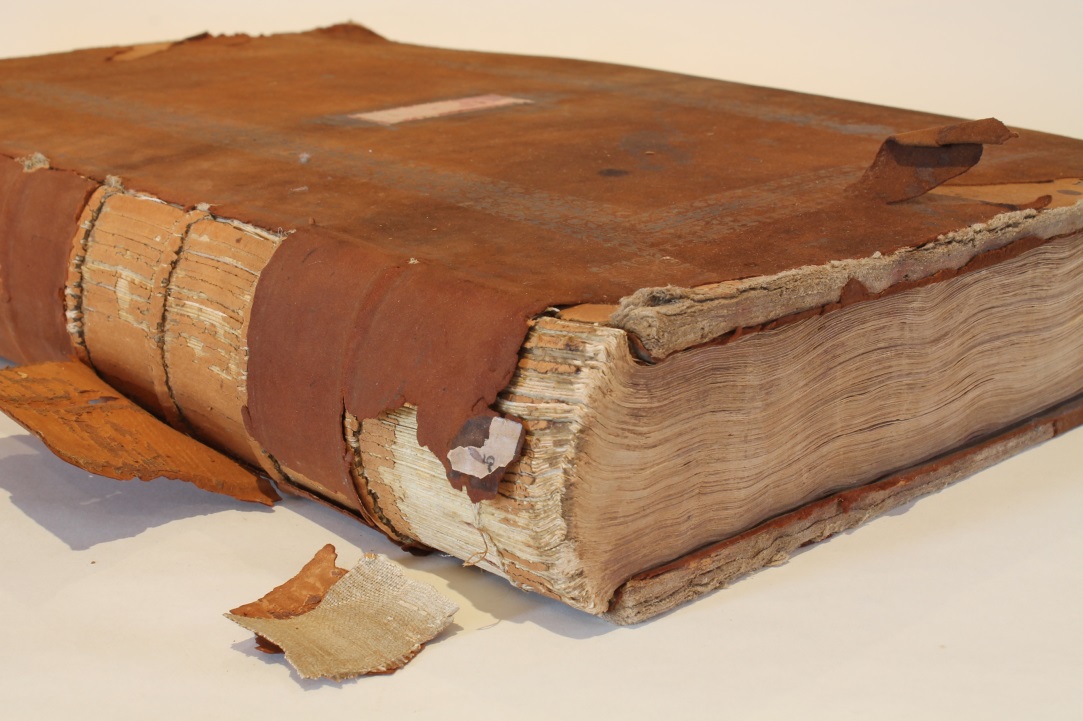The conservation of a four-volume set of 18th century folio library catalogues was recently completed for Balliol College Library.
The catalogues are large, heavy books bound in brown, reverse sheep leather and contain a printed Bodleian catalogue of 1738 with Balliol’s holdings underlined or noted on interleaved manuscript pages. They form the main record of the large donation left to the College by George Coningesby in 1768. Books belonging to him are marked ‘Cy’ in the catalogue.
These working books showed signs of handling commensurate with their 300-year life in a busy library. Because of their poor condition the books could not be safely consulted without fear of causing further damage.
One of the main problems to be addressed during the project was the weak board attachments; the sewing was still intact but the leather had split along the joints and the cord supports were weak or had completely split. A key element of the treatment proposal was to reinstate the missing endbands. New endbands would not only restore the former aesthetic of the books, they would also form an important structural part of the in-situ repair. The endbands would provide extra strength to the board attachment, and support to the heavy text-blocks, without having to completely re-sew the leaves. None of the original endbands had survived; however, fragments of thread (tie-downs) still present between the leaves were evidence that they did exist, and that they were alternating blue and natural linen colour – typical of those commonly found on 18th century Oxford bindings.[1]
By the 1700’s endbands had lost much of their structural function as bookbinders tried to keep up with increased demand: what was once part of the mechanics, had by this point become simply a decorative part of the binding. [2] Therefore, new endbands were devised for the Coningesby catalogues which took inspiration from earlier medieval bindings; the new endbands would match those now lost but would offer the much needed support which hadn’t been provided before.

New structural endbands were created using a traditional medieval two-part process: strong primary thread wound around a thick linen core to form the base of the structure, and then thinner coloured thread worked over the top to for decoration.[3] Rather than lacing the cores through new holes pierced into the boards, a less invasive approach was to splay out the ends and paste them between the layers of board which had been laminated together. This provided a strong connection between the loose boards and the text-block. It was important that the new endbands should sit harmoniously with the original binding so new threads were hand-dyed with natural indigo to match the thread that survived. Hand dyeing threads rather than using pre-dyed thread offered a better range to choose from and produced a good match to the distinctive natural indigo colour used in the early 18th century.

The conserved catalogues can now be safely consulted in the Library once more. The new medieval inspired endbands have contributed to a sympathetic but robust repair which should help to extend the life of these unique books for many years.

By Arthur Green
Book Conservator greensbooks.co.uk
References
[1] David Pearson, Oxford Bookbinding 1500-1640, (Oxford Bibliographical Society, 2000), 50.
[2] Nicholas Pickwoad, Onwards and Downwards: how binders coped with the printing press before 1800, (Oak Knoll Press, 1994), 80.
[3] For more information on medieval endbands see: Arthur Green, A compensation endband: a structural endband for a book with uneven edges. (Journal of the Institution of Conservation Vol. 39(2), 2016) 158-169.

Interesting that the board edges are simply consolidated, and not recovered, from what I see on the pictures. Did you use toned japanese paper on the spine?
Concise, constructive, informative. Thank you!